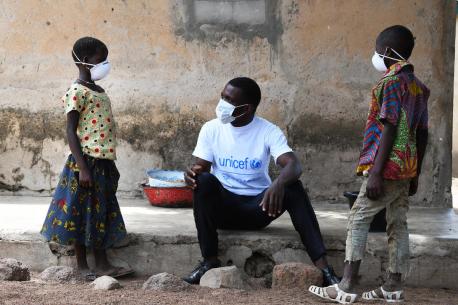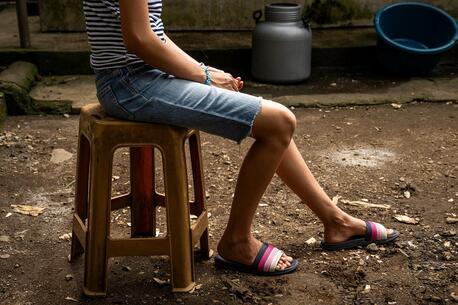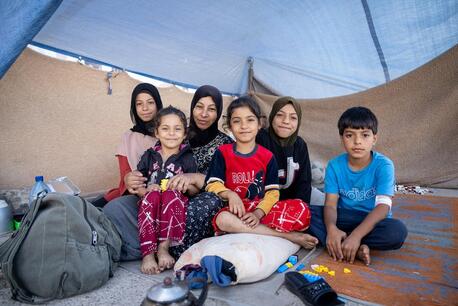
A Deep Dive Into UNICEF's $1.6 Billion Pandemic Response
The different components of UNICEF's plan to deal with the COVID-19 crisis reflect just how much is at stake for the world's most vulnerable children and families.
If we do not support poorer countries as they battle the pandemic, we are leaving the virus to spread unchecked and circle back around the world. That is in no one's interest. Nor is economic collapse and instability in fragile and poor countries.
It is in all our interests to come together in an urgent and coordinated response to this pandemic in the world's most fragile settings.
— Mark Lowcock, Under-Secretary-General for Humanitarian Affairs and Emergency Relief Coordinator, United Nations
The global response to the COVID-19 pandemic is a complex, multi-layered, all-hands-on-deck endeavor. An unprecedented level of action is required to tackle the myriad impacts of both the disease itself and the restrictions meant to contain it — to make sure children, who have so far been disproportionately spared the worst forms of the illness, do not become its hidden victims.

Hamsatou, 13, washes her hands at a camp for displaced families in Mopti, Mali, where UNICEF is helping to improve health and hygiene and communicate best practices for COVID-19 prevention. After some training in community outreach, Hamsatou is now a peer leader who goes door to door in the camp, helping to spread awareness among other children and young people about the need for social distancing and regular handwashing with soap. © UNICEF/UNI332257/Keïta
UNICEF — a leading member of the United Nations Crisis Management Team, comprised of 10 UN agencies — recently updated its fundraising appeal to donors and supporters for $1.62 billion to cover response efforts through December 2020.
The unprecedented size of this appeal reflects the devastating socioeconomic consequences of the disease and families' rising needs. With the outbreak now in its sixth month, the costs for supplies, shipment and duty of care are also increasing dramatically.

UNICEF's risk communication efforts include promoting hygiene knowledge and best practices in communities like Klongtoey, Thailand. UNICEF is also distributing soap, hand sanitizer and other hygiene supplies to households in need to assist families on lockdown during the COVID-19 pandemic. © UNICEF/UNI325679/Preechapanich
Strategic priority No. 1 is to save lives, care for the sick and prevent the spread of infection. But there are other priorities too, because for UNICEF, COVID-19 is not just a health crisis, it is a child rights crisis. And urgent action is needed to protect children from its knock-on effects.
UNICEF's $1.62 billion response plan encompasses all of this, while concentrating efforts on countries with existing humanitarian crises: a pledge to deliver support and services to the most vulnerable children and families, to improve their access to health care, nutrition, water and sanitation, education and protection.
The work has already begun. With partner networks and critical delivery systems and infrastructure already in place all across the globe — UNICEF has a presence in over 190 countries and territories, including in the 63 focus countries — UNICEF was able to get moving quickly, rushing six metric tons of medical supplies to the front lines even before the World Health Organization declared the novel coronavirus a global health emergency.
Three months on, all UNICEF divisions are reporting strong results toward their year-end targets. But there's an enormous amount of work still ahead.

Supplies arrive in Nigeria to assist in the fight against COVID-19. © UNICEF/UNI322101
Here's a look at six components of UNICEF's response plan and the progress made so far:
1. COMMUNICATION
UNICEF is heavily involved in efforts to communicate the risks of COVID-19 and how to curb transmission, while also dispelling potentially harmful rumors and myths, through targeted public information campaigns. Key objectives include conveying the importance of washing hands, and the best way to do it; encouraging the use of health services for testing and seeking care; and helping to rally entire communities in fighting the virus as well as any stigma attached to those affected by it.

Kolo, 10, practices social distancing with his friend Chris, 6, in Korhogo, north Côte d'Ivoire. © UNICEF/UNI325661/Dejongh
Campaigns are carried out in a number of ways: mass media, social media, peer-to-peer communication (e.g. WhatsApp groups led by youth volunteers) and public meetings with community leaders (like a town hall). UNICEF's U-Report mobile platform has also proven to be an invaluable engagement tool, now deployed in 50 countries to support the exchange of critical COVID-19 related information.
RESULTS: 1.7 billion people reached with information about COVID-19 prevention and access to services
YEAR-END GOAL: 2.24 billion reached
2. HEALTH
A big part of UNICEF's response efforts is ensuring vital medical supplies and personal protective equipment reach the most vulnerable communities, while helping to build the capacities of frontline health workers to detect and manage COVID-19 cases.
UNICEF is also working with partners to sustain essential maternal, newborn and child health services — including immunizations.
With health systems disrupted, vaccination rates are slipping in countries around the world — including in the U.S. Over 117 million children in 37 countries may miss out on their measles vaccinations as national campaigns are put on hold, according to UNICEF estimates.
While working to maintain vaccine supplies, UNICEF is also helping governments track immunity gaps and get ready to resume vaccination campaigns as soon as it is safe to do so.
RESULTS: nearly 11 million children and women have received essential health care services in UNICEF-supported facilities
YEAR-END GOAL: 90 million reached
Mental health is another area of concern. Since the start of the pandemic UNICEF had reached over 830,000 children, parents and caregivers with community-based mental health and psychosocial support — just 3 percent of the number it aims to reach by the end of the year.

UNICEF-supported health workers are masked and ready to administer measles vaccines to children in Goma, Democratic Republic of Congo as part of a campaign in North Kivu province. Measles cases surged in the DRC in 2019 as the country focused on fighting Ebola, and now COVID-19 has further strained the health system. © UNICEF/UNI325342/Nkoy
3. WATER, SANITATION AND HYGIENE (WASH)
Regular, thorough handwashing is essential to prevent the spread of COVID-19, but an estimated 40 percent of the world’s population lack the means to wash their hands with soap and water at home.
UNICEF and partners have been working to upgrade water and sanitation systems, install handwashing facilities in schools, health centers and other public places, and distribute soap, hand sanitizers and other hygiene supplies to households in need.
RESULTS: over 12 million people reached with critical WASH supplies
YEAR-END RESULTS: 56 million reached

Kitka Goyol, WASH Chief for UNICEF Ethiopia, inspects a hands-free hand washing station designed by Steven Mugarra, a UNICEF WASH engineer. © UNICEF/UNI331425/Tesfaye
Another important WASH-related piece of the response plan is training community and facility health care workers in infection prevention and control. So far 308,000 workers have received that training out of the 2.33 million UNICEF aims to reach by the end of the year.
4. NUTRITION
Malnutrition rates are expected to rise among the nearly 370 million children across 143 countries who normally rely on school meals as a primary food source. As a counter measure, UNICEF is working to ensure that women and children have continued access to pre-and post-natal care and essential nutritional supplies such as Vitamin A, Zinc and micronutrients, either in-person or through online platforms.
UNICEF also works to ensure that kids who suffer from severe acute malnutrition can get care at a nearby health facility.
RESULTS: over 464,000 children (aged six months to 5 years) admitted for treatment of severe acute malnutrition
YEAR-END GOAL: 4.4 million admitted

Nutritionist Dessy Sandra Dewi counsels the mother of a 2-year-old girl during a home visit in Paseban Village in Klaten, Central Java, Indonesia. © UNICEF/UNI329168/Ijazah
5. EDUCATION
Nearly 1.3 billion students (approximately 74 percent) are affected by school closures. One of UNICEF's priorities is to help kids continue to learn, safely. Working with governments, educators and other local partners, UNICEF has been supporting the development and implementation of alternative learning programs and content — provided online, broadcast on TV or radio or through Learning Passport, an innovative digital platform developed by UNICEF in partnership with Microsoft.
RESULTS: nearly 80 million children supported with distance or home-based learning
YEAR-END GOAL: 305 million supported

9-year-old Maria and her father follow a pre-recorded lesson on her father’s smartphone in a tent at the Kili camp for displaced families in rural Idlib, Syria. Schools are closed all across Syria and informal schooling in the camps has been suspended due to physical distancing rules. UNICEF is helping by providing learning materials to help kids continue their studies on their own and with help from parents, among other learning alternatives. In Maria's camp, volunteer teachers have created Whatsapp groups to stay connected to their students. One teacher told UNICEF, "The pre-recorded lessons aren’t a substitute for the classroom, but it is the best alternative we have for now.” © UNICEF/UNI322057/Suleiman
6. PROTECTION
While sheltering in place during a lockdown, vulnerable kids can face a higher risk of deprivation, exploitation and abuse. UNICEF works with social workers and other local partners to strengthen their abilities to detect cases of neglect and abuse and to intervene with support and protective care. UNICEF also provides technical and other expertise to assist with case management and guide health workers who may be in a position to help.
RESULTS: Almost 3.5 million children and adults have access to a safe channel for reporting sexual exploitation and abuse
YEAR-END GOAL: 5.2 million with access
For details on how UNICEF is responding to COVID-19 in individual countries, check out the situation reports
Specific interventions within each of these categories are tailored to each country and local context. Want to know what's happening in Senegal, Turkey or Vietnam? How about Ethiopia or Azerbijan? UNICEF's frequently updated (and publicly available) situation reports provide a detailed accounting of UNICEF's deployments by country and by region.
Each investment is intended to end suffering and repair damage caused by COVID-19 while also strengthening health and social support systems and building community resilience against future crises — to build back better, and greener.
Your contribution will help UNICEF prevent new infections through public health education and outreach; provide health facilities with critical supplies and other support; and scale up child protection services, among other efforts.
Top photo: In the village of Morovine, in northern Côte d'Ivoire, a UNICEF staffer counsels children on the importance of wearing masks or face coverings to protect themselves against the novel coronavirus. © UNICEF/UNI325656/Dejongh
HOW TO HELP
There are many ways to make a difference
War, famine, poverty, natural disasters — threats to the world's children keep coming. But UNICEF won't stop working to keep children healthy and safe.
UNICEF works in over 190 countries and territories — more places than any other children's organization. UNICEF has the world's largest humanitarian warehouse and, when disaster strikes, can get supplies almost anywhere within 72 hours. Constantly innovating, always advocating for a better world for children, UNICEF works to ensure that every child can grow up healthy, educated, protected and respected.
Would you like to help give all children the opportunity to reach their full potential? There are many ways to get involved.





